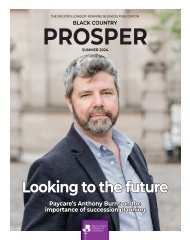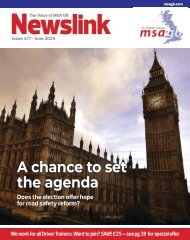Newslink October 2021
Membership magazine of the Motor Schools Association; road safety, driver training and testing news.
Membership magazine of the Motor Schools Association; road safety, driver training and testing news.
Create successful ePaper yourself
Turn your PDF publications into a flip-book with our unique Google optimized e-Paper software.
For all the latest news, see www.msagb.com<br />
(37.5p). Compulsory testing was brought<br />
in on 1 June 1935 for all drivers and<br />
riders who started driving on or after 1<br />
April 1934: around 246,000 candidates<br />
applied for a test, and the pass rate was<br />
63%. Between 9 and 16 half-hour tests<br />
were conducted each day by 250<br />
examiners.<br />
Those passing the motorcycling test<br />
did not need to take another test to drive<br />
a car. The test was conducted by the<br />
examiner positioning themselves at a<br />
point where they could observe the<br />
motorcyclist’s riding, such as beside a<br />
common or in a city square.<br />
In the case of sidecar outfits or<br />
three-wheelers, the examiner might have<br />
accompanied the rider.<br />
Examiners were responsible for<br />
handling the booking of driving tests.<br />
They met candidates at pre-arranged<br />
locations such as car parks or railway<br />
stations because there were no test<br />
centres. Anyone buying a driving licence<br />
must put ‘L’ plates on the car and<br />
eventually take a driving test to get their<br />
full licence<br />
1937: Provisional licences were brought<br />
in for heavy goods vehicle (HGV) drivers.<br />
1939-45: Driving tests were suspended<br />
on 2 September 1939 for the duration of<br />
World War 2. During the war, examiners<br />
were redeployed to traffic duties and<br />
supervision of fuel rationing.<br />
HGV licences and tests were<br />
suspended on 1 January 1940 because<br />
of World War 2.<br />
1946: Testing resumed on 1 November<br />
1946 following the end of World War 2<br />
the previous year.<br />
1947: The Motor Vehicles (Driving<br />
Licences) Regulations placed<br />
motorcyclists in their own licence group,<br />
but testing remained virtually unchanged<br />
until the 1960s.<br />
On 18 February 1947, a period of 1<br />
year was granted for wartime provisional<br />
licences to be converted into full licence<br />
without passing the test.<br />
1950: The pass rate for the driving test<br />
was 50%.<br />
1956: The test fee doubled from 10<br />
shillings (50p) to £1 on 19 <strong>October</strong><br />
1956.<br />
Testing was suspended from 24<br />
November 1956 during the Suez Crisis.<br />
Learners were allowed to drive<br />
unaccompanied, and examiners helped<br />
to administer petrol rations. Testing did<br />
not resume until on 15 April 1957 after<br />
the crisis had passed.<br />
Provisional licences were no longer<br />
stamped with ‘passed test’ from 15 July<br />
1957.<br />
The 3-year driving licence was<br />
introduced on 1 September 1957 under<br />
the Road Traffic Act 1956. The fee for a<br />
replacement licence, if lost or defaced,<br />
rises by 150% from 1 shilling (5p) to 2s<br />
6d (12.5p).<br />
1958: From 1 March 1958, provisional<br />
licences are valid for 6 months.<br />
1959: A new examiner training facility<br />
was acquired at Stanmore training<br />
school, near Heathrow. Until then,<br />
examiners were trained ‘on the job’.<br />
1961: From 1 July 1961, learner riders<br />
were restricted to machines of no more<br />
than 250cc capacity in order to deal with<br />
the high number of motorcycling<br />
fatalities.<br />
1962: From 1 April 1962, people who<br />
had held more than seven provisional<br />
licences were required to take a driving<br />
test. If they failed to do so, the licensing<br />
authority could refuse a further<br />
application for a licence.<br />
1963: The Road Traffic Act 1962<br />
permitted riders to ride motorcycles of<br />
more than 250cc after passing their test.<br />
New grouping systems were introduced<br />
for driving tests and driving licences and<br />
a distinction was made between the test<br />
of competence and the test of fitness.<br />
Mopeds were placed in their own vehicle<br />
group for driving test purposes.<br />
1964: A voluntary register of approved<br />
driving instructors (ADIs) was set up<br />
under the Road Traffic Act 1962. To<br />
become an ADI, you had to pass<br />
stringent written and practical tests.<br />
1965: Centralised licensing system was<br />
set up at the new Swansea Driver and<br />
Vehicle Licensing Centre (DVLC), taking<br />
over licence issue from County/Borough<br />
councils.<br />
The application form for a driving or<br />
motorcycle licence was revised from 1<br />
May 1965. The medical standard for<br />
eyesight was changed. The distance from<br />
which a driving test candidate must be<br />
able read a number plate was changed to<br />
67 feet for 3 1/8-inch-high characters.<br />
• See years from 1965-present in<br />
November’s <strong>Newslink</strong><br />
Top 10 driving<br />
test facts<br />
The car driving test was first taken<br />
in 1935, meaning it is now 86...<br />
not long before it gets a<br />
congratulatory telegram from<br />
Buckingham Palace! Here are some<br />
of the top 10 driving test facts:<br />
• Mr Beere was the first person to<br />
pass the driving test in 1935: he<br />
paid the grand total of 7s 6d<br />
(37.5p) to take the test.<br />
• There were no test centres in<br />
1935 so you had to arrange to<br />
meet the examiner somewhere like<br />
a post office, train station or town<br />
hall.<br />
• The test was suspended for the<br />
duration of World War 2 and didn’t<br />
resume until 1 November 1946.<br />
• In 1975, candidates no longer<br />
had to demonstrate hand signals.<br />
• The theory test was introduced<br />
in 1996, replacing questions about<br />
The Highway Code during the<br />
practical test.<br />
• Driving was much more<br />
hazardous when the test was<br />
introduced. In 1935 7,343 people<br />
were killed on Great Britain’s roads<br />
despite the fact that there were<br />
only 2.4 million vehicles in use.<br />
Nowadays there are over 30 million<br />
vehicles on the road; our roads<br />
death toll is around 1,800 a year<br />
• Candidates could book their<br />
theory test online for the first time<br />
in December 2001.<br />
• The driving test pass rate in<br />
1935 was 63 per cent – compared<br />
to arounf 46% now.<br />
• 1969 saw the first driving test<br />
set for an automatic vehicle.<br />
• Since 1935 more than 50 million<br />
tests have been taken.<br />
NEWSLINK n OCTOBER <strong>2021</strong><br />
27

















